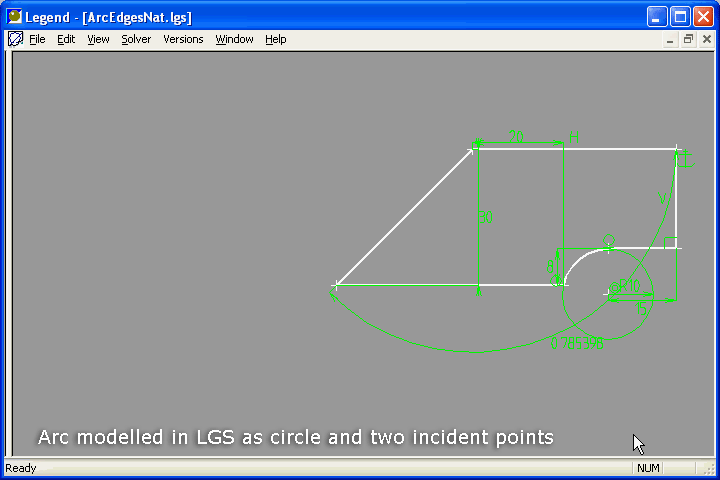Latest release of LGS 2D now parametrically controls bounded geometry
LEDAS Ltd today announced version 6.0 of LGS 2D, its 2D geometric constraint solver. As the core technology of parametric software packages, LGS 2D allows users to express design intent in sketches and drawings through geometric, dimensional, and engineering constraints.
Previous versions of LGS 2D modeled only untrimmed geometric objects, such as points, infinite lines, and full circles. Version 6.0 adds the ability to deal with boundary geometries, like segments, circular arcs, and elliptic arcs. It also computes more natural solutions, as preferred by most CAD users.
New: Segments and Arcs as Edges
LGS 2D 6.0 implements segments and arcs as new types of entities. Jointly, they are known as edges. Edges can be interpreted as new kinds of geometric objects and as ternary constraints. (The latter means that each edge is created on top of three LGS2D objects -- a line, circle, or ellipse, and two points -- and then imposes two coincidence constraints between the first object and each point.)
In addition, the endpoints of edges keep their order during the constraint solving process. For segments, this means that the direction of lines is always oriented from the first to the second end point. (This direction can be reverted by modifying the edge’s alignment attribute.)
Each edge also has a length attribute, with values of free, fixed, or linked to a variable. Circular and elliptic arcs have the angle attribute with the same properties.
Through edges, any LGS-based application can provide users with full parametric control over their drawings, which is unreachable when the geometry is modeled with unbounded objects (i.e., lines, circles, ellipses) that are connected with two incident points. An example can be found in the video at http://ledas.com/EdgeConstraints.php.

Edges also represent a special case of dependent curves with three control objects. This means that they can be linked with other geometries using the appropriate constraints, such as incidence with a point, and tangency to a line. For example, when users set the incidence constraint between a point and a segment, then the point will always lie between the segment's endpoints. This is behavior that cannot be modeled with unbounded geometry.
Edges gain the advantage over user-defined curves in the area of improved performance. This is achieved from the application of analytical methods and decomposition techniques to solve the constraints.
Edges are implemented as a new add-on module for LGS 2D named LGSProfiles. Programmers can use edges in the same way as they do other LGS 2D objects. In the future, LEDAS plans to extend the LGSProfiles module with other bounded geometries, such as composite and offset curves.
The LGSProfiles module is licensed with LGS 2D at an additional price. Please contact sales@ledas.com for details.
Other Improvements in LGS 2D
Version 6.0 produces more natural solutions for several constraint scenarios. The solver implemented two new techniques to minimize changes to the model, and to keep the sketch as close as possible to the initial drawing. These techniques work effectively for scenarios with one to three unsatisfied constraints, which are typical for interactive sketcher applications.
"Version 6.0 opens a new direction of the development for our 2D constraint solver," said Ivan Rykov, Director of R&D of Component Technologies at LEDAS, Ltd. "This was requested by our customers, whose satisfaction is the priority for our development direction."
About LGS Software
Since the first commercial release in 2004, LGS 2D and 3D software components have been licensed by a dozen CAD/CAM/CAE vendors, who have embedded them into their applications successfully.
The LGS 2D and 3D geometric constraint solvers are used as parametric engines for 2D sketching and drawing, direct 3D modeling, assembly design, motion analysis, and other applications. LGS 2D/3D are cross-platform software packages running on 32- and 64-bit versions of Windows, Linux, Mac OS X, *BSD, AIX, HP-UX, and other operating systems. LGS 2D and 3D have a C-style API for easy integration into a broad range of software applications using a variety of wrappers, such as .NET, Java, and C++.
LGS 2D and 3D support the creation and modification of geometric models by means of explicit and implicit constraints. Geometric objects that can be constrained include points, lines, circles, ellipses, planes, cylinders, spheres, NURBS, application-defined parametric curves, and surfaces. Objects can be fixed in the absolute coordinate system or relative to each other. Supported constraints include geometric relations between objects (coincidence, parallelism, tangency, and so on) and dimensions that specify the required values for distances, angles, and radii. LGS 2D and 3D move and rotate objects to positions that satisfy all constraints, yet minimize transformations from initial configurations.
Other LGS functions implement advanced features of CAD/CAM/CAE systems, such as diagnostics of over- and under-defined parts of models, engineering variables and equations, help points, and tolerance management.
Example applications Lege’n’d 2D/3D are available as free downloads from the LEDAS web site. This collection of sample models represents different kinds of 2D sketches and 3D assemblies that can be constructed from LGS. The associated applications can be used to test the functionality, robustness, and performance of LGS 2D/3D. The sample applications were all created with the Open CASCADE open-source application framework; the source code is available to all licensees.
All members of Open Design Alliance can easily integrate the LGS 2D geometric constraint solver with a Teigha for .dwg files client application, which provides easy access to constraint solving functions. A sample application demonstrating a number of constraint-related features can be found on the ODA web site.
To learn more about LGS 2D/3D, visit the LEDAS Web site at www.ledas.com/products/lgs2d.
About LEDAS
LEDAS Ltd. is a private, employee-owned software development company founded in 1999. It provides constraint-based design tools, component technologies, and software development services for the CAD/CAM/CAE/PDM market.
For more information about LEDAS, see www.ledas.com.
LGS is a trademark of LEDAS Ltd. Any other trademarks are the property of their respective owners.